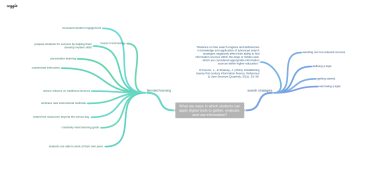My questions was; how can we teach students critical thinking skills along with digital literacy so that they can successfully analyze and evaluate information they find?
It has become crucial that learning structures are change and adapt to accommodate the new digital environment that exists today. Students must become proficient with not only digital information, but also digital tools. This is instrumental in all jobs and disciplines. Modern students are typically immersed in technology and use it for their own personal and casual needs. Teachers may assume that students are capable of successfully transferring these skills to academic work, but this is something students struggle with. It is important to see where students are at, and go from there. They need to develop the skills and gain knowledge on how to conduct higher level applications. For example, students need to dig deeper and go beyond free search engines when doing academic research. Teachers can support students by teaching them ways to research information for higher education purposes. They can help them identify topics, and narrow those topics down. Educators can help students see what information can be eliminated based on irrelevance or unreliable sources. We are living in a digital age in which the way we communicate and the way we find information has changed drastically. Students need to learn not only how to use technology, but they need to possess digital literacy and critical thinking skills. With so much information at their fingertips, they need to be able to identify credible resources. Blended learning allows for school to go outside the classroom walls and to extend beyond the normal school day hours. Students can work at their own pace, and receive customized instruction. Blended learning is a way of teaching students modern skills they can use in the future. Students tend to be more engaged because they are actively participating in their own learning. They can gain a much deeper understanding through their own self-guided investigation.
Sources:
Morrison, R., & Greenfield, D. (2015). Towards an Assumption Responsive Information Literacy Curriculum: Lessons from Student Qualitative Data. Retrieved July 21, 2015, from http://digitalcommons.nl.edu/faculty_publications/48/
O’Connor, L., & Sharkey, J. (2013). Establishing twenty-first-century information fluency. Reference & User Services Quarterly, 53(1), 33–39.
Wong, W. (2014). How technology enables blended learning. EdTech Focus on K-12. Retrieved from http://www.edtechmagazine.com/k12/article/2014/04
/how-technology-enables-blended-learning


I liked how you defined blended learning at the end and it’s benefits pertaining to your question. Great job!
LikeLike
Thank you for reading and commenting 🙂
LikeLike
Hi Danielle, I agree that it is very important to make sure that students are able to identify credible sources. I also liked how you touched upon the fact that some students struggle applying technology to academic work. Just because students are familiar with technology for personal use does not mean they are comfortable applying it in an academic setting. Great post!
LikeLike
Yes, they are very different uses and applications. Thank you for reading and commenting.
LikeLike